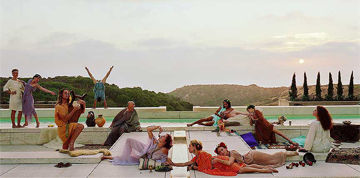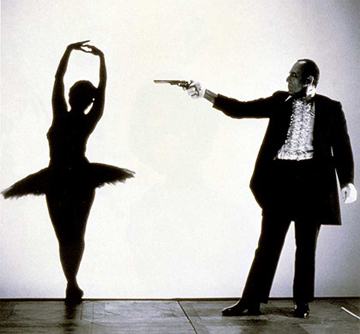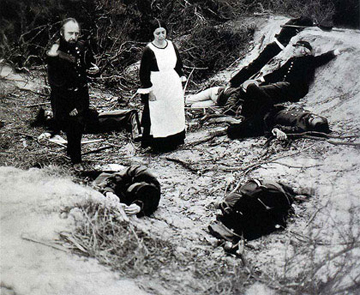Last month I had the good fortune to speak with Eleanor Antin (Season 2) in a series of lively and engaging emails that included her thoughts on preparing for exhibitions, working with allegories, making “controversial” or “risky” art, teaching art, and working with actors (vs. models). Below is the first of two parts. Tune in tomorrow for the nail-biting conclusion. Many thanks to Eleanor for being so candid (and patient!), as we worked on the interview right through the holidays.

Eleanor Antin, The Death of Petronius from The Last Days of Pompeii, 2001. Chromogenic print, 46 5/8 x 94 5/8 inches. All images courtesy Ronald Feldman Fine Arts, New York.
Joe Fusaro: When you share a series of work or create a proposal for an exhibit, what are some things you think about going into the process?
Eleanor Antin: Historical Takes at the San Diego Museum of Art was a mini retrospective of the work I’ve been doing over the last eight years. Earlier, I had a full retrospective from the late 60’s through 1999 at LACMA and I traveled with that huge show to several museums, including St. Louis and the UK while wondering, ‘where the hell do I go from here?’ Somewhere around that time, one sunny afternoon, I was driving down the mesa to La Jolla, the ocean sparkling blue green below me, La Jolla gleaming in the bay, when suddenly I had an apperçu that hit me with a strange sad power. La Jolla was Pompeii, rich and gleaming, without a clue that it was on the verge of annihilation. Pompeii was where the rich and powerful had gone to escape the heat, stink, and mosquitoes of the Roman summers, where those senators fortunate enough to live that long in the notoriously insecure world of imperial Rome went to retire. Extend the metaphor, and you have the ancient empire merging with ours, where affluent citizens lived the good life innocent of the destruction lurking just around the corner.
So since then, I’ve been working with myths, metaphors, characters, and settings invented out of the ancient world of classical Greece and Rome, all the time aware that these are really my neighbors. Maybe we don’t have a volcano on our doorstep, but with global warming, climate freakiness, wild fires, water loss, disease migrations, economic destabilization, terrorist vengeance—hey, we’re on a roll here….

Love’s Shadow, 1985. 16mm film, black-and-white, 2 1/2 minutes.
For me a show is always motivated by a generative metaphor, a kind of poetic image which opens up to related ideas, images, ambiguities, dreams, sensations. Nothing is closed, there is no end. If the viewer wants to keep looking and has a playful mind, my work can be like a hall of mirrors, expanding and suggesting new meanings which, in turn, may suggest others. Poussin and Magritte are among my favorite artists. They may have different sensibilities but their works are always restless and fluid. Unfortunately, I find the art world too ready to summarize and simplify. I’m often embarrassed by the simplistic takes even well-meaning critics may have on my work. I become a couple of declarative sentences in a stranger’s mouth.
JF: Why do you think some people consider your work controversial? How do you respond to this reaction?
EA: I’m confused when people consider my work “controversial.” Or the word most often used is “brave.” I don’t know what they mean. This isn’t Soviet Russia or Hitler’s Germany—yet. Those countries may have been intellectually monstrous and physically murderous but they seemed to think artists were important enough to persecute. Here, relatively few people care what artists do. This allows us freedom even if it assures us of irrelevance. So to call me brave is silly.
A well-known curator once said disapprovingly to me, “you always do whatever you want to do.” What should I do? What he wanted to do? You can say the art world cares what we artists do. But who are they, this art world? Dealers? Curators? Critics? Collectors? Other artists? Fellow travelers? I’ve been with a great dealer, Ronald Feldman, since 1977 and he respects artists and assumes we will do whatever we want to do. Curators come and go. Critics have deadlines and space constraints. Collectors? Oh, please! They don’t know what they want until somebody tells them. Hopefully they have intelligent advisors, but they often don’t. Other artists, yes, they’re the best part of the art world, though many of them seem to feel that there’s a war out there, so they’re often in survival mode. They won’t always tell you how much your work means to them and that can make you unhappy, or even sometimes buggy, but hell, if they get ideas from you and you stimulate or provoke their work, isn’t that a good thing after all? It just means that there’ll be more good art around.

The Angel of Mercy, 1977. In the Trenched of Sebastopol from My Tour of Duty in the Crimea. One of 38 tinted gelatin-silver prints, mounted on handmade paper with text, 30 x 22 inches.
JF: The San Diego Museum of Art describes your work as “affectionate spoofs on classical culture with metaphorical parallels to the excesses of contemporary consumer economy.” Is “affectionate” a word you would use to describe the latest work and if so, how is it “affectionate”?
EA: I don’t do spoofs and if I’m feeling affectionate, I’ll adopt a puppy.
JF: Fair enough…I had a feeling. You mentioned the drive to La Jolla being powerful and influencing your work. Is this a way you’re often inspired—through driving, trips, and time to reflect on your own? Or was this atypical in terms of the way you often get ideas?
EA: Somehow, by the time I finish a project, there’s always a new one waiting just around the corner. Since my works are always projects with numerous parts, they usually take several years for me to play out their implications. Sometimes I feel like I’m peeling away the layers of an onion, at other times I’m opening up a peapod.
For instance, back in the 70’s when I began working with different personas (a king, a ballerina) and I was ready to take on a nurse persona, I remember walking through Brooklyn Heights past a nurse’s dormitory with large stuffed animals in many of the windows. Teddies, tigers, whatever. Wow! These were grown women studying to become nurses and they were still kids at heart. Those cuddly creatures, endearing and kind of dumb, reminded me of when I was a kid. I used to run home from school every day to play with my paper dolls in an ongoing soap opera of love, murder (I was especially fond of stabbings with pencil points), theft (like one of the ugly dolls stealing the excessive and glamorous clothes of a richer, prettier doll), illness, death (the corpse was buried in an earth-filled cheese box that stood for years on the windowsill of my room). Unless, that doll was found guilty of murder and was executed by being torn into pieces and flushed down the toilet. It was an ongoing saga that continued from day to day in a kind of desperate attempt to represent actual experienced time in the equally desperate, improvised manner of the soaps.
So that was the kind of nurse I would be and I made paper dolls to act out romances and disasters on video (The Adventures of a Nurse, The Nurse and the Hijackers). Then, I was about to do Dug-out Nurse, in which the little nurse becomes manager of a losing baseball team and is treated badly by the macho players until she brings them around and gets them to win the pennant, when I realized, ‘Hey, this loveable little bimbo isn’t the true story of nurses, except in the pornographic pop culture fantasies of the times. What about the founder of nursing as a profession for women, the great heroine of the Crimean War, Florence Nightingale?’ So I made larger, life scale, masonite “puppets” to enact the performance and videotape sections of my huge photographic project about caregiving, war, and capitalism, The Angel of Mercy. All because I happened to take a walk one day down a quiet urban side street.
Continued tomorrow in Part 2.




Pingback: Interview with Eleanor Antin Part 2 | Art21 Blog
Pingback: Nail Biting Annihilation – Latest Nail Biting Annihilation news – Moon (Review) | Cut Print Review | Stop Nail Biting Now
Pingback: Nail Biting Annihilation – YouTube – [CLIP] 1R0N sick M4 shot by sHibbyyy
Pingback: Nail Biting Annihilation – Latest Nail Biting Annihilation news – Moon (Review) | Cut Print Review
Pingback: Teaching with Contemporary Art: The First Three Years | Art21 Blog
Pingback: Why to shoot in Black and White | Qudos Animations